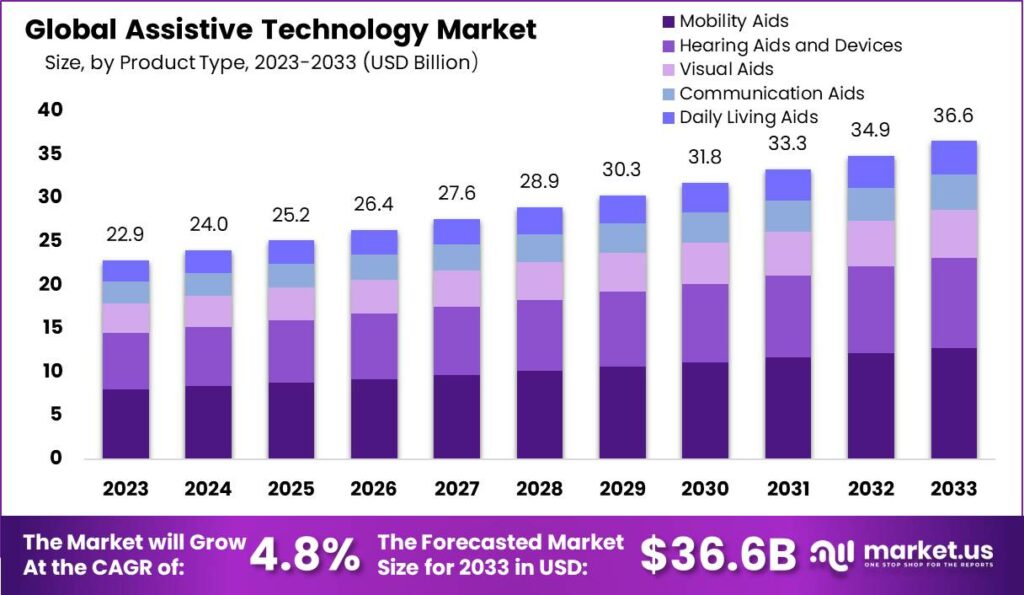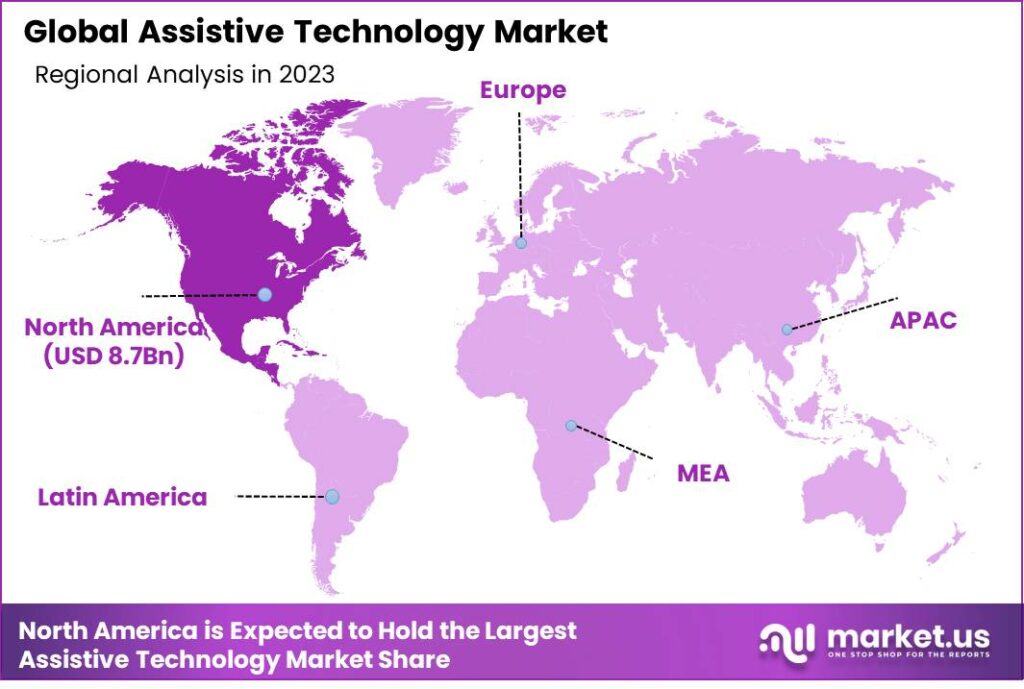
Assistive Technology Market Expected to Exceed USD 36.6 Billion by 2033
Introduction
According to Market.us, The Global Assistive Technology Market size is expected to be worth around USD 36.6 Billion by 2033, from USD 22.9 Billion in 2023, growing at a CAGR of 4.8% during the forecast period from 2024 to 2033.
Assistive technology refers to a broad range of tools, devices, and systems designed to enhance the functional capabilities of individuals with disabilities. These technologies aim to improve quality of life, promote independence, and facilitate inclusion in various aspects of daily living, education, employment, and social participation. From mobility aids such as wheelchairs and walkers to communication devices, screen readers, and specialized software, assistive technology encompasses diverse solutions tailored to address specific needs and challenges faced by people with disabilities.
The assistive technology market has witnessed significant growth in recent years, driven by several factors including an aging population, increasing prevalence of disabilities, advancements in technology, and rising awareness about accessibility and inclusion. The global assistive technology market is projected to continue expanding, with a focus on innovation, customization, and affordability.
Key players in the market include manufacturers, developers, and service providers collaborating to develop cutting-edge solutions that empower individuals with disabilities to lead more independent and fulfilling lives. As governments and organizations worldwide recognize the importance of accessibility and disability rights, the assistive technology market is poised for further growth, with opportunities for innovation, investment, and collaboration across sectors.
Tap into Market Opportunities and Stay Ahead of Competitors – Get Your Sample Report Now

Key Takeaways
- Steady Growth: The global assistive technology market is expected to reach USD 36.6 billion by 2033, with a consistent Compound Annual Growth Rate (CAGR) of 4.8% from 2024 to 2033.
- Dominant Segments: In 2023, the mobility aids segment emerged as the leading player in the assistive technology market, accounting for over 35% of the market share. Similarly, hospitals and clinics represented the dominant segment, capturing more than 27% of the market share, while online retailers held a significant share of over 33%.
- Regional Leadership: North America stood out as the dominant region in the global assistive technology market in 2023, commanding over 38% of the market share.
Factors affecting the growth of the Assistive Technology Market
- Demographic Trends: An aging global population and increasing prevalence of chronic diseases such as diabetes and cardiovascular conditions significantly contribute to the rising demand for assistive technologies. These devices are crucial for enhancing the quality of life for individuals with disabilities and the elderly, helping them maintain independence and mobility.
- Technological Advancements: Innovations in technology are pivotal in driving the expansion of the assistive technology market. Developments in areas like artificial intelligence (AI), robotics, and wearable technology have led to the creation of more sophisticated and user-friendly products. These advancements not only improve the functionality of assistive devices but also make them more accessible to a broader user base.
- Government Policies and Funding: Supportive government initiatives and funding are critical for market growth. Policies that mandate the provision of assistive devices in public sectors and educational institutions, coupled with funding for research and subsidies for users, create a conducive environment for market expansion.
- Market Awareness and Education: Increasing awareness and education about the benefits and availability of assistive technologies also play a crucial role. Educational campaigns and training programs for healthcare professionals and end-users can lead to higher adoption rates.
- Economic Factors: The affordability of assistive technologies can be a significant barrier for many potential users. Economic conditions that influence consumer spending power and healthcare funding directly impact market growth. However, efforts to reduce costs through economies of scale or subsidized pricing models are helping to make these technologies more accessible.
- Global Expansion and Localization: The globalization of businesses including those in the assistive technology sector presents opportunities and challenges. Adapting products to meet the regulatory and cultural needs of different regions is crucial for international market penetration.
Drive Your Business Growth Strategy: Purchase the Report for Key Insights!
Regional Analysis
In 2023, North America held a commanding position in the global assistive technology market, securing a market share exceeding 38%. The region’s market for assistive technology was valued at approximately USD 8.7 billion in the same year. This substantial market valuation is projected to experience significant growth over the coming years.
Several factors contribute to North America’s prominence in this sector. The region benefits from a robust healthcare infrastructure, a high degree of technological integration, and widespread awareness of the benefits of assistive technology. Additionally, North America has a substantial aging population, which drives the demand for products that can enhance quality of life for seniors and individuals with disabilities.
Moreover, North America’s market dominance is supported by comprehensive government policies that encourage the use of assistive technology. These policies often include funding for individuals requiring these technologies, as well as incentives for research and development within the sector.
Furthermore, the presence of key industry players in the North American market fosters innovation and ensures a steady supply of advanced technologies. These companies are pivotal in developing cutting-edge solutions that address a range of disabilities and mobility issues, thereby expanding the market’s reach and influence.

Driver: Technological Innovations
Technological innovations are a primary driver for the assistive technology market. The integration of advanced technologies such as artificial intelligence, machine learning, and the Internet of Things (IoT) into assistive devices has substantially enhanced their functionality and user-friendliness. Innovations such as voice recognition, real-time translation features, and mobility assistance through robotics have made assistive devices more adaptable and effective for users with diverse needs. These advancements not only improve the quality of life for individuals with disabilities but also broaden the scope of applications for assistive technology in daily activities, thereby driving market growth.
Restraint: High Cost of Advanced Technologies
The high cost of advanced assistive technologies remains a significant restraint in the market. Many of the cutting-edge devices that incorporate the latest technologies such as AI and robotics are expensive to produce and, consequently, to purchase. This makes them inaccessible to a significant portion of the population, particularly in low- and middle-income regions. Moreover, the lack of sufficient insurance coverage or subsidies for such devices limits their adoption, as individuals and healthcare providers may opt for less advanced but more affordable alternatives. Addressing these cost issues is crucial for expanding the reach of advanced assistive technologies to all segments of the population.
Opportunity: Aging Global Population
The global increase in the aging population presents a substantial opportunity for the assistive technology market. As life expectancy increases, there is a growing need for products that can assist the elderly in maintaining independence and managing chronic illnesses. Assistive technologies such as wearable health monitors, emergency response systems, and mobility aids are increasingly in demand. This demographic shift is prompting companies to innovate and expand their product ranges to meet the specific needs of older adults, opening new avenues for growth in the market.
Challenge: Regulatory Compliance
Navigating the complex regulatory landscape poses a significant challenge for players in the assistive technology market. The requirement for compliance with varying regulations across different countries can complicate the development, approval, and distribution of new products. Regulatory hurdles can delay the launch of innovative solutions and incur additional costs, impacting the overall pace of innovation and market entry. Furthermore, the dynamic nature of regulatory frameworks requires companies to continually adapt, adding layers of complexity to their operations and strategic planning.
Top Market Leaders
- Sonova Holding AG
- GN Store Nord A/S
- William Demant Holding A/S
- Invacare Corporation
- Ottobock SE & Co. KGaA
- Drive DeVilbiss Healthcare
- MED-EL Medical Electronics
- Tobii Dynavox
- Cochlear Limited
- Enabling Devices LLC
- Permobil AB
- Freedom Scientific (VFO Group)
- Other Key Players
Recent Developments
- On September 8, 2023, Body Vision Medical, a pioneering firm specializing in AI-driven intraoperative imaging, entered into a global distribution agreement with Mediflex, recognized for its innovative surgical devices. This partnership enables Body Vision Medical to distribute Mediflex’s Bronchoscope Stabilization System (BSS) worldwide, enhancing their product portfolio and market reach.
- Vuzix Corporation, a leader in Smart Glasses and Augmented Reality (AR) technology, announced a significant distribution agreement with ASK Corporation of Japan on June 14, 2023. The agreement, marked by a large volume purchase order from ASK, allows Vuzix to expand its distribution network across Japan, leveraging ASK’s strong presence in the IT equipment sector.
- In a notable event on January 6, 2023, coinciding with World Braille Day, the Vasantha-Krupa Palakurthi Vision-Aid Resource Centre of Excellence – Institute for Vision distributed 26 Smart Vision Devices. These AI-based wearables assist the visually impaired in reading, navigating, and recognizing people and objects, underscoring the commitment to empowering individuals with vision impairments.
Key Market Segments
Product Type
- Mobility Aids
- Wheelchairs
- Scooters
- Walking Aids (canes, crutches)
- Transfer Lifts
- Hearing Aids and Devices
- Hearing Aids
- Cochlear Implants
- Assistive Listening Devices
- Visual Aids
- Screen Readers
- Braille Displays
- Magnifiers
- Electronic Glasses
- Communication Aids
- Augmentative and Alternative Communication (AAC) Devices
- Speech Generating Devices
- Daily Living Aids
- Adaptive Kitchen and Dining Tools
- Adaptive Clothing and Dressing Aids
- Environmental Control Devices
End-User
- Hospitals and Clinics
- Rehabilitation Centers
- Elderly Care Facilities
- Educational Institutions
- Individual Users
Distribution Channel
- Online Retailers
- Specialty Assistive Technology Stores
- Hospitals and Clinics
- Government Agencies and NGOs
Explore More Reports
- Chiplets Market is anticipated to be USD 107.0 billion by 2033. It is estimated to record a steady CAGR of 42.5% in the forecast period.
- Artificial Intelligence market is anticipated to be USD 2,745 billion by 2032. It is estimated to record a steady CAGR of 36.8%.
- Drone Market is anticipated to achieve a value of roughly USD 101.1 Billion by 2032, CAGR of 12.7% during the projection period.
- Cloud Computing Market size is expected to be worth around USD 2,974.6 Billion by 2033, growing at a CAGR of 16.8%.
- Semiconductor Market is anticipated to be USD 1,307.7 bn by 2032. It is estimated to record a steady CAGR of 8.8% in the forecast period.
- Metaverse market is Expected to Accumulate a Value of USD 2,346.2 Billion by 2032 from USD 94.1 Billion in 2023; Registering a CAGR of 44.4%.
- Generative AI Market is estimated to reach USD 255.8 Billion by 2033, Riding on a Strong 34.2% CAGR throughout the forecast period.
- Podcasting market is anticipated to be USD 233.9 bn by 2033. It is estimated to record a steady CAGR of 27.8% in the forecast period.
- EdTech Market size is expected to be worth around USD 549.6 Billion by 2033, from USD 146.0 Billion in 2023, growing at a CAGR of 14.2%.
Contact Data
Global Business Development Teams – Market.us
Market.us (Powered By Prudour Pvt. Ltd.)
Email: inquiry@market.us
Address: 420 Lexington Avenue, Suite 300 New York City, NY 10170, United States
Tel: +1 718 618 4351
Website: https://market.us/
Editor Details
-
Company:
- Wired Release
- Website:
